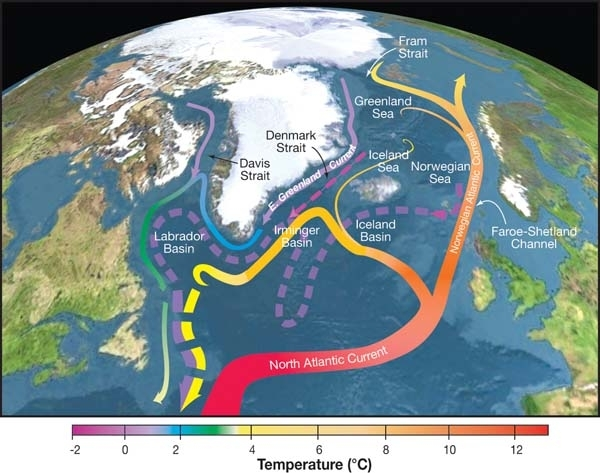Nov 18 2020
A new study notes that humans should decrease carbon dioxide and aerosol pollution at the time same to prevent the weakening of the ocean’s potential to maintain the planet cool.
 Map of a portion of the Atlantic meridional overturning circulation, which carries warm water up past Europe, and could be weakened without a simultaneous reduction in CO2 and aerosols. Image Credit: R. Curry, Woods Hole Oceanographic Institution/Science/USGCRP.
Map of a portion of the Atlantic meridional overturning circulation, which carries warm water up past Europe, and could be weakened without a simultaneous reduction in CO2 and aerosols. Image Credit: R. Curry, Woods Hole Oceanographic Institution/Science/USGCRP.
Aerosol pollution is defined as particles in the air discharged by vehicles and factories that burn fossil fuels. This pollution causes bronchitis, asthma, and long-term irritation of the respiratory tract, which can result in cancer.
The conundrum is that aerosols cause poor air quality and lead to premature deaths. However, these particles have a net cooling impact on the climate, so when you cut them that leads to a net warming effect.
Robert Allen, Study Co-Author and Climate Scientist, University of California-Riverside
A majority of the studies have investigated the effects of aerosol on air quality and land surface temperatures. How aerosols might affect the oceans is underexplored, which is the aim of a UC Riverside study recently reported in the Science Advances journal.
The researchers have developed elaborate computer models to find out the effect on oceans under two distinct scenarios—one where there is just a decrease in aerosols, and the other where greenhouse gases such as methane and carbon dioxide are also decreased.
The first scenario leads to the surprising result that fewer aerosols in the atmosphere could shift the region where most of the ocean is taking up heat, from the Southern Ocean toward the North Atlantic.
Robert Allen, Study Co-Author and Climate Scientist, University of California-Riverside
The study has specifically found that the Atlantic meridional overturning circulation (AMOC) would be interrupted as aerosols are eliminated from the air. The AMOC draws warm water further north and drives colder water south, thus ensuring a comparatively mild climate on land areas at higher latitudes like Europe.
Approximately half the carbon dioxide humans release into the air—mainly via deforestation and fossil fuel combustion—remains there, and the other half is absorbed by vegetation and land, as well as the ocean.
One way the ocean absorbs carbon dioxide emissions is via AMOC circulation.
A projected decline in manmade aerosols potentially induces a weakening of the AMOC, which plays an important role in ocean heat uptake and storage in the North Atlantic.
Wei Liu, Assistant Professor of Climate Change and Sustainability, University of California-Riverside
Besides, the scientists stated that an increase in sea level would take place if the North Atlantic Ocean were to become warmer.
The focus of this study was on the uptake and circulation of ocean heat through the AMOC. But Allen noted that they did not try to meticulously determine the mechanisms by which aerosol reductions weaken the AMOC. Those mechanisms will be investigated in future studies.
Finally, the team concludes that even without an elaborate description of the weakening mechanisms, it is essential to decrease greenhouse gases and aerosols at the same time.
The Intergovernmental Panel on Climate Change suggests making sincere efforts to prevent the planet’s temperature from reaching 1.5 °C above pre-industrial levels to prevent the worst impacts of global warming.
Already, humans have increased carbon dioxide levels by nearly 50% since the 1850s, and it has been increasing globally. Stabilizing carbon dioxide at existing levels would necessitate zero net emissions before 2070, which is challenging, but crucial.
“Assuming complete removal, aerosols at most will cause warming of about 1 K,” stated Allen. “However, aerosol-induced warming, as well as the associated ocean circulation changes, can be moderated by rigorous cuts in greenhouse gases including methane and carbon dioxide.”
Journal Reference:
Ma, X., et al. (2020) Dependence of regional ocean heat uptake on anthropogenic warming scenarios. Science Advances. doi.org/10.1126/sciadv.abc0303.